Morschach
Morschach is a municipality in Schwyz District in the canton of Schwyz in Switzerland.
Morschach | |
|---|---|
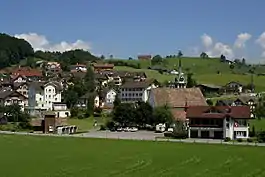 | |
 Coat of arms | |
Location of Morschach 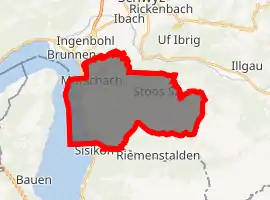
| |
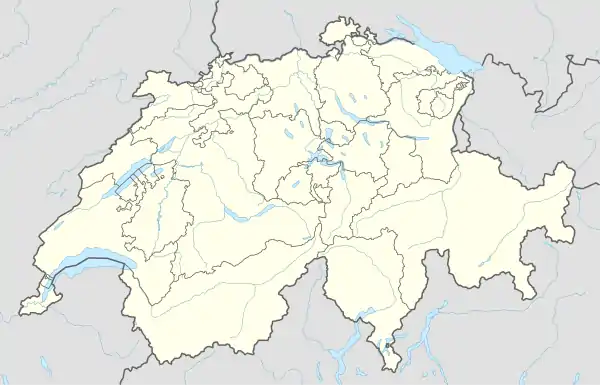 Morschach 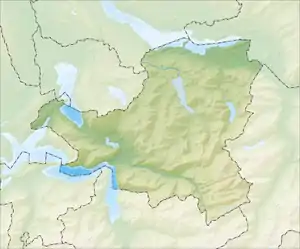 Morschach | |
| Coordinates: 46°58′N 8°37′E | |
| Country | Switzerland |
| Canton | Schwyz |
| District | Schwyz |
| Area | |
| • Total | 23.4 km2 (9.0 sq mi) |
| Elevation | 650 m (2,130 ft) |
| Population (2018-12-31)[2] | |
| • Total | 1,159 |
| • Density | 50/km2 (130/sq mi) |
| Time zone | UTC+01:00 (Central European Time) |
| • Summer (DST) | UTC+02:00 (Central European Summer Time) |
| Postal code(s) | 6443 |
| SFOS number | 1366 |
| Surrounded by | Ingenbohl, Muotathal, Riemenstalden, Seelisberg (UR), Sisikon (UR), Schwyz |
| Website | www SFSO statistics |
History
Morschach is first mentioned in 1261 as Morsacho.[3]
Geography
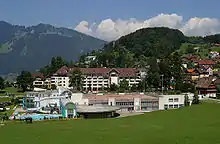
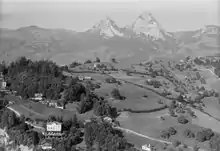
Morschach has an area, as of 2006, of 20.8 km2 (8.0 sq mi). Of this area, 52.3% is used for agricultural purposes, while 36.2% is forested. Of the rest of the land, 2.9% is settled (buildings or roads) and the remainder (8.6%) is non-productive (rivers, glaciers or mountains).[4]
The municipality is located on a glacier moraine above the Lake of Lucerne. It consists of the village of Morschach and includes the summer and winter sport center at Stoos.
Demographics
Morschach has a population (as of 31 December 2019) of 1,148.[5] As of 2007, 14.7% of the population was made up of foreign nationals.[6] Over the last 10 years the population has grown at a rate of 9.3%. Most of the population (as of 2000) speaks German (89.0%), with Serbo-Croatian being second most common ( 2.0%) and Portuguese being third ( 1.7%).[4]
As of 2000 the gender distribution of the population was 54.4% male and 45.6% female. The age distribution, as of 2008, in Morschach is; 274 people or 28.6% of the population is between 0 and 19. 331 people or 34.6% are 20 to 39, and 247 people or 25.8% are 40 to 64. The senior population distribution is 67 people or 7.0% are 65 to 74. There are 36 people or 3.8% who are 70 to 79 and 3 people or 0.31% of the population who are over 80.[6]
As of 2000 there are 305 households, of which 75 households (or about 24.6%) contain only a single individual. 27 or about 8.9% are large households, with at least five members.[6]

In the 2007 election the most popular party was the SVP which received 45.6% of the vote. The next three most popular parties were the CVP (26.3%), the SPS (16%) and the FDP (8.6%).[4]
In Morschach about 57.2% of the population (between age 25-64) have completed either non-mandatory upper secondary education or additional higher education (either university or a Fachhochschule).[4]
Morschach has an unemployment rate of 1.41%. As of 2005, there were 70 people employed in the primary economic sector and about 32 businesses involved in this sector. 15 people are employed in the secondary sector and there are 6 businesses in this sector. 434 people are employed in the tertiary sector, with 42 businesses in this sector.[4]
From the 2000 census, 710 or 74.1% are Roman Catholic, while 65 or 6.8% belonged to the Swiss Reformed Church. Of the rest of the population, there are 6 individuals (or about 0.63% of the population) who belong to the Orthodox Church, and there are less than 5 individuals who belong to another Christian church. There are 13 (or about 1.36% of the population) who are Islamic. There are less than 5 individuals who belong to another church (not listed on the census), 66 (or about 6.89% of the population) belong to no church, are agnostic or atheist, and 95 individuals (or about 9.92% of the population) did not answer the question.[6]
The historical population is given in the following table:[3]
| year | population |
|---|---|
| 1850 | 462 |
| 1900 | 518 |
| 1950 | 587 |
| 1980 | 632 |
| 1985 | 771 |
| 1990 | 824 |
| 2000 | 848 |
| 2005 | 893 |
| 2007 | 938 |
References
- "Arealstatistik Standard - Gemeinden nach 4 Hauptbereichen". Federal Statistical Office. Retrieved 13 January 2019.
- "Ständige Wohnbevölkerung nach Staatsangehörigkeitskategorie Geschlecht und Gemeinde; Provisorische Jahresergebnisse; 2018". Federal Statistical Office. 9 April 2019. Retrieved 11 April 2019.
- Morschach in German, French and Italian in the online Historical Dictionary of Switzerland.
- Swiss Federal Statistical Office accessed 31-Aug-2009
- "Ständige und nichtständige Wohnbevölkerung nach institutionellen Gliederungen, Geburtsort und Staatsangehörigkeit". bfs.admin.ch (in German). Swiss Federal Statistical Office - STAT-TAB. 31 December 2019. Retrieved 6 October 2020.
- Canton Schwyz Statistics Archived 2011-06-09 at the Wayback Machine (in German) accessed 27 August 2009
External links
| Wikimedia Commons has media related to Morschach. |
